

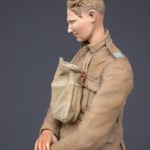
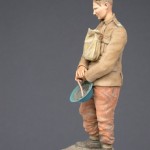

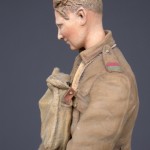
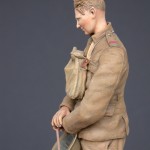
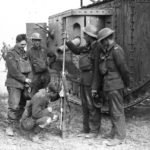
Private, 4th Battalion Tank Corps, France 1918 – Special Offer / Bt. Panzerfahrer, Frankreich 1918 – Sonderangebot
- Scale / Maßstab: 1:16
- Approx. height of figure: 118mm
- Material: Resin (figure), Model Plaster (base) / Resin (Fugur), Modell-Gips (Sockel – synethetische, kunststoffveredelte Gießmasse)
- Parts / Teile: 11
- Infosheet / Infoblatt: English
- Code: 10TF
Contents / Inhalt:
- Figure (8 parts) / Figur (8 Teile)
- Alternative Head with Glengarry / 2. Kopf mit Glengarry-Mütze
- Small Box Respirator Bag / Gasmaskenbeutel
- British Steel Helmet Mk.1 / Bt. Stahlhelm Mk.1
- Figure Base / Figur-Sockel
Extracts from the Infosheet with this figure:
The figure depicts a private, 4th Battalion (originally D Company, later A Battalion), Tank Corps, France 1918. A young man, standing relaxed holding his blue painted steel helmet. The original photograph shows him standing with 4 other comrades beside a male British Tank inspecting a capture German anti-tank rifle. On his service dress he wears the blue sewn on shoulder tally colours of the 4th Bn. The small-box respirator hangs in the alert position in front of the chest.
The Tank Corps formed in May 1916, was designated the Heavy Section, Machine Gun Corps and then in November of the same year became the Heavy Branch. Not until July 1917 did it eventually become the Tank Corps. Formed from volunteers, it had up until 1917 no badge of its own. The white worsted MK1 tank badge (this was a male tank with 57mm cannons – the female tank had only machine guns) issued on the 7th May 1917 was worn on the upper right service dress sleeve. By the end of the war the Tank Corps had 26 numbered battalions, along with various workshop and support units.
Head 1: This is the head of the soldier taken from the original photograph. If one holds the head in front of a light, then it is possible to see where parts of the hair have been modelled thinly – notably the wave of hair hanging down between the left eye and ear and directly above. These thin areas can be removed using a sharp blade giving the hair an extra lightness.
Head 2: Here I have tried to acquire a slightly rougher / working-class look on the face of this young Scotsman. He wears the traditional Glengarry of the Scottish infantry regiments. Also known as the Glengarry bonnet or cap this brimless form of headdress was invented by Alasdair Ranaldson MacDonell of Glengarry and made out of a thick-milled woolen material with a bobble, or toorie on top and 2 ribbons hanging from the rear.
In 1914 all Scottish infantry regiments, except the Cameronians (Scottish Rifles) and Scots Guards wore the dark blue Glengarry (on many photographs this dark blue will nearly always appear black). The border or band had a red, black and white dicing with the brass regimental cap badge mounted onto a black silk background or rosette. The toorie (bobble) has a different colour depending on regiment. The cap badge is of the Argyll and Southern Highlanders – a Stag’s Head above the motto CUIDICH’N RIGH (Help the King).
The regiment was originally formed by the amalgamation in 1881 of the old 78th or Seaforth’s Highlanders, later the 72nd Highlanders (Duke of Albany’s Own), and the 78th or Ross-shire Buffs. During World War 1 the regiment was made up of 19 battalions and saw action on the Western Front, Mesopotamia, Macedonia and Palestine. Only the 1st and 2nd battalions were regulars, the others consisted of the Special Reserve, Territorial and War Service Battalions.
Today apart from Scottish regiments serving with the British Army the Glengarry is also worn by civilian pipe bands and as an appropriate headdress by any male highlander. There is also an Irish Glengarry. The method of wearing the Glengarry during this period was to have it sat at an angle on the head, with the right side nearly touching the ear. Nowadays it is worn more or less squarely on the middle of the head.
Service Dress M1902: The standard battle dress of the British Army in World War 1. On each side are the brass support hooks for the belt support. Beneath the shoulder straps at the front are the reinforced rifle patches. On his right lower sleeve are two overseas stripes – these would normally be in blue. The buttons were of brass (Rifle or Light Regiments in the British Army wore black buttons). The Tank Corps used shoulder tally colours – either sewn on patches (as on the figure) or slip-over slides. Colour: khaki – an Urdu word meaning dusty. The dye for the material originally came from India and was made out of tea, or mud. It was said that this colour, a kind of dull brownish- yellow was more suited to the battlefields of France and Belgium than the German blue- grey.
Scottish regiments, particularly at the beginning of the war, wore a slightly different style service dress – this had the Scots cutaway skirts at the front. Photographs show that in the late war period at least some Scottish units wore the more common English version of the service dress.
Puttees: An Indian word meaning bandages. Designed to cover the gap between boot and trousers, keeping the lower leg warm and dry. Colour: khaki.
Ammunition Boots: From 1918 a new type of boot was issued with a reinforced sole and toecap. The figure is wearing this type of boot. Colour: black.
 An deutschsprachige Interessenten:
Sie können mich per eMail oder Telefon auch gerne auf deutsch kontaktieren. Ortsbesuch ist nach Absprache möglich.
An deutschsprachige Interessenten:
Sie können mich per eMail oder Telefon auch gerne auf deutsch kontaktieren. Ortsbesuch ist nach Absprache möglich.
